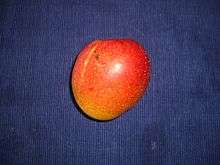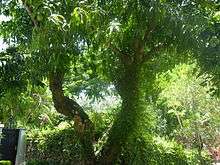Haden (mango)
| Mangifera Indica 'Haden' | |
|---|---|
 | |
| Cultivar | 'Haden' |
| Origin | Grown from a Mulgoba mango seed planted in Coconut Grove, Florida in 1902. |
The 'Haden' mango (or, 'Hayden') is a named mango cultivar that became one of the most widely cultivated in the world after it was introduced in the early 20th century through south Florida. It would ultimately become the parent of many other mango cultivars later developed in Florida.[1]
History

In 1902, Captain John J. Haden, a retired U.S. army officer living in Coconut Grove, Florida, planted four dozen[2] seedlings of 'Mulgoba' mangoes he had purchased from Professor Elbridge Gale in Mangonia, near Lake Worth Lagoon in the area of present-day West Palm Beach. Haden would die the following year, but his wife Florence cared for the trees at their property in Coconut Grove, which first fruited in 1910.[3] One tree in particular produced superior quality fruit, with brilliant color and good flavor. This cultivar was selected and given the family name. Both historical and pedigree analysis indicates that 'Haden' was likely the result of a cross between 'Mulgoba' and a 'Turpentine' mango.
Florence Haden, realizing the potential of the cultivar, reported its success to the Florida State Horticultural Society, and sent two specimens of the fruit to the United States Department of Agriculture, and another larger mango to Edward Simmonds of the Plant Introduction Station at Miami.[4] Simmonds was immediately intrigued and eventually took up propagating the 'Haden' in south Florida. 'Haden' became a big commercial success, largely due to its large-scale propagation by nursery-owner George Cellon, and would dominate the mango industry in the state for roughly 25 years,[5] as well as being introduced to other locations with great success, such as Honduras, Hawaii[6] and Australia. 'Haden' gradually fell out of favor as a commercial mango largely due to fungus problems, along with inconsistent production, problems with internal breakdown of the fruit (also known as jelly seed), and the availability of new varieties with superior characteristics. Most of the mango varieties subsequently developed in Florida were either direct or indirect descendants of 'Haden'.
Named mango varieties that are likely directly descended from Haden include:
- Allen-King/Everbearing
- Anderson (Haden x Sandersha cross)
- Bailey's Marvel (Haden x Bombay cross)
- Becky (Haden x Brooks cross)
- Cogshall
- Cushman (Haden x Amini cross)
- Earlygold
- Edward
- Fascell (Haden x Brooks cross)
- Glenn
- Hatcher (Haden x Brooks cross)
- Hodson
- Jacquelin (Haden x Bombay cross)
- Kent (Haden x Brooks cross)
- Irwin (Haden x Lippens cross)
- Lippens
- Osteen
- Palmer
- Parvin
- Ruby
- Sensation (Haden x Brooks cross)
- Southern Blush (Haden x Cushman cross)
- Spirit of '76 (Haden x Zill cross)
- Springfels
- Tommy Atkins
- Torbert
- Valencia Pride
- Van Dyke
- Winters (Haden x Ono cross)
- Zill (Haden x Bombay cross)
Despite falling out of favor as a commercial production mango, 'Haden' remained one of the most widely propagated mangoes for nursery stock and home growing throughout the decades, and continues to be today.
'Haden' trees are planted in the collections of the USDA's germplasm repository in Miami, Florida,[7][8] the University of Florida's Tropical Research and Education Center in Homestead, Florida,[9] and the Miami-Dade Fruit and Spice Park,[10] also in Homestead. The original tree still stands in Coconut Grove.
Description
[[File:Mango Haden Asit fs8.jpg|thumb|A display of mature 'Haden' frui
References
- ↑ http://fshs.org/Proceedings/Password%20Protected/2005%20v.%20118/118/192-197.pdf
- ↑ http://www.fshs.org/Proceedings/Password%20Protected/1910%20Vol.%2023/135-140%20%28WEEKS%29.pdf
- ↑ http://www.stcarlos.ca/mangos.htm
- ↑ http://fcit.usf.edu/florida/docs/m/mangos.htm
- ↑ Campbell, Richard J. (1992). A Guide to Mangos in Florida. Fairchild Tropical Garden. p. 73. ISBN 0-9632264-0-1.
- ↑ http://www.hort.purdue.edu/newcrop/morton/mango_ars.html
- ↑ http://www.ars-grin.gov/cgi-bin/npgs/acc/display.pl?1575283 USDA, ARS, National Genetic Resources Program. Germplasm Resources Information Network - (GRIN). [Online Database] National Germplasm Resources Laboratory, Beltsville, Maryland.
- ↑ http://www.ars-grin.gov/cgi-bin/npgs/acc/display.pl?1097824 USDA, ARS, National Genetic Resources Program. Germplasm Resources Information Network - (GRIN). [Online Database] National Germplasm Resources Laboratory, Beltsville, Maryland.
- ↑ http://trec.ifas.ufl.edu/crane/pdfs/TREC-Fruit-Collections.pdf Page 3, #41
- ↑ http://fruitandspicepark.org/friends/index.php?option=com_content&task=view&id=43&Itemid=29